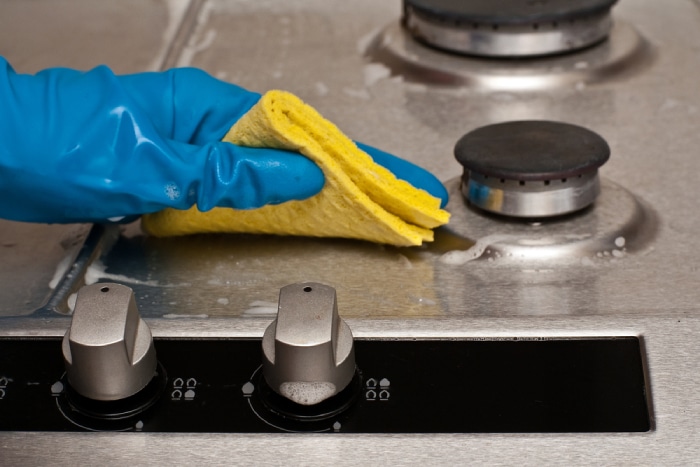Imagine this: you’re cooking a delicious meal on your gas stove, only to notice an unsettling orange flame dancing beneath your precious pot. A sense of unease washes over you, mingled with a hint of alarm. Why is my gas stove flame orange? Is it safe? Fear not, fellow home chefs! In this comprehensive guide, we’ll embark on a culinary quest to uncover the mystery of the orange flame and empower you with the knowledge to rectify the situation.

Image: diyjoy.com
Understanding the Chemistry of Flames
Before we delve into the intricacies of fixing an orange flame, let’s take a quick chemistry lesson. The color of a flame is determined by its temperature and the presence of certain chemical elements. In the case of natural gas, a blue flame is the ideal scenario, indicating complete combustion. This occurs when the gas mixes evenly with oxygen, resulting in the production of carbon dioxide, water vapor, and heat.
However, when there is an imbalance in the gas-to-oxygen ratio, incomplete combustion can occur. This leads to the formation of carbon monoxide and other byproducts, which emit a telltale orange glow.
The Culprits Behind the Orange Flame
Now that we understand the chemistry behind the orange flame, let’s investigate the potential causes:
-
Improper Air-to-Gas Ratio: The most common reason for an orange flame on a gas stove is an incorrect air-to-gas ratio. This can be caused by a clogged or misaligned gas burner or a lack of sufficient oxygen in the surrounding environment.
-
Dirty Burner Ports: Over time, food particles and grease can accumulate on the burner ports, obstructing the flow of gas and air. This can lead to uneven combustion, resulting in orange flames.
-
High Wind or Drafts: If your stove is located in a drafty area, the wind can interfere with the combustion process, disrupting the air-to-gas ratio and causing the flame to turn orange.
The Path to a Blue Flame
Fear not, dear reader! Restoring the coveted blue flame to your gas stove is not a daunting task. Here’s a step-by-step guide to help you achieve combustion perfection:
-
Clean the Burner Ports: Remove the burner grates and carefully clean the burner ports with a toothpick or a soft brush. Ensure that there is no debris or blockages.
-
Adjust the Gas-to-Air Ratio: Locate the air shutter on the burner base. Using a screwdriver, adjust the shutter until the flame turns blue. Be cautious and only make small adjustments at a time.
-
Check for Drafts: If you suspect strong winds or drafts are affecting your stove, try cooking in a more sheltered area or using a draft guard.
-
Contact a Gas Professional: If, despite your valiant efforts, the orange flame persists, it’s prudent to contact a certified gas technician. They can inspect the gas lines, burners, and other components to ensure everything is working correctly and safely.

Image: ricecomel1970.blogspot.com
Expert Insights and Actionable Tips
To further empower you on your fiery quest, let’s seek wisdom from renowned culinary experts:
-
Chef Julia Child: “A well-adjusted gas flame is crucial for cooking success. The blue flame provides even heat distribution, preventing scorching or undercooking.”
-
Chef Gordon Ramsay: “Don’t be afraid to get your hands dirty! Cleaning the burner ports is essential for achieving a pristine blue flame.”
In addition, here are some practical tips to consider:
-
Use a Damp Cloth: To prevent scratches, use a damp cloth to wipe down the burner ports after cleaning.
-
Follow Manufacturer’s Instructions: Refer to your stove’s user manual for detailed cleaning instructions and safety precautions.
-
Vent the Kitchen: While cooking with gas, ensure adequate ventilation in your kitchen to avoid the buildup of combustion byproducts.
How To Fix Orange Flame On Gas Stove
https://youtube.com/watch?v=ed96qc77N-o
Conclusion: Embracing the Blue Flame
With the knowledge and techniques shared in this article, you possess the power to conquer the orange flame enigma and restore the tranquility of your gas stove. By understanding the chemistry behind flames, identifying potential causes, and implementing practical solutions, you can bid farewell to the orange glow and embrace the culinary bliss of the unwavering blue flame. Remember, a well-maintained gas stove not only enhances your cooking experience but also ensures the safety of your home. So, ignite your culinary passion, embrace the blue flame, and let the aroma of delicious meals fill the air!